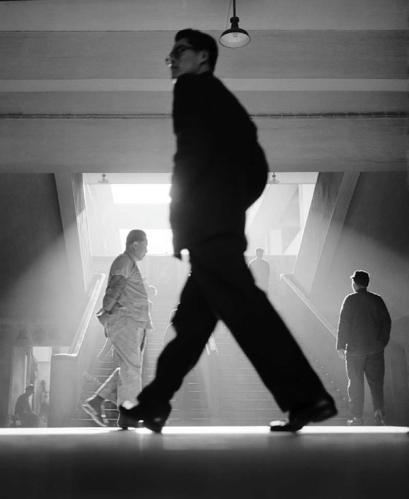5. Look for Angles that are Not Ninety Degrees. The Beauty of 120 Degrees.
Ninety degree angles naturally appear everywhere. Fan Ho often created images using angles other than ninety degrees, often approximating 120 degrees.
Angles other than ninety are unexpected and more interesting. The angles of the shadows in this image are much wider than ninety, giving a more diagonal feel to the lines rather than the straight line feel of ninety degree angles.
The repetition of the Light Edges are combined with Long Shadows to highlight the single subject, and then move the eye across to the two subjects towards the bottom right of the image – at least, that is how my eye moves across this image!
6. Top and Bottom Frame Composition.
Like most photographers, I am guilty of not considering the whole frame when composing images. It is a difficult trap to escape from – gravity pulls most compositions to centre middle of the frame. One of the most important steps a person with an inspiration to improve is to start putting the subject in frame off centre – normally using the rule of thirds.
Fan Ho often uses unexpected portions of the frame to build an image. His use of the Top and Bottom Frame of the image is a lesson in seeing possibilities.
Most compositions focus on the bottom third of the image, whereas Ho balances compositions with objects at the top and bottom of the frame. Hong Kong is a particularly cool place to explore this compositional technique – there are things hanging over the narrow streets and laneways everywhere.
All three compositions feature a key point of interest in the top third of the frame. Keep looking towards the top of each of your frames when composing.
Whilst there are not the same crowded narrow streets in Melbourne, or in most cities for that matter, actively considering options in the Top Frame can produce great results.
7. High and Low Perspectives
Most photographs are taken from a height of somewhere between 5ft and 6ft. The perspective of the world at the height of the human head is something most of us experience every day. Changing the perspective from which you take a shot – getting higher or lower than you would normally expect to view a subject from – is an easy way to increase interest in a composition. The advice “to get down low to the same level of a toddler” when taking a portrait of a kid can also be applied to street photography.
We see the world everyday from the same height. Changing where a composition is viewed from presents a new side or way of understanding the scene.
In the first image, Ho has lowered the camera to close to, or at floor level. This changes the angle at which we see the main subject in the centre of the frame to a “bottom up” perspective. It also shifts the relationship the main subject has with the “Light Funnel” (more to come on Light Funnels) behind him. The view is subtly different from what the eye would expect at head height, and contributes to the interest in the composition.
The second image has also been taken from a Low Perspective, from the bottom of the stairs. Getting lower on this shot helps Ho backlight the subjects and frame them to some degree using the Top Frame fabrics hung over the lane, and the darker bottom stairs in the Bottom Frame.
The third image uses a very simple technique of just shooting from the bottom of a set of stairs. Instead of pointing the camera upwards, just shoot straight ahead – the lens should be at shoe height for subjects. A perspective you don’t naturally see.
The final image is an example of getting up high and shooting down to create interest. There is also use of Ho’s trademark Long Shadow technique. There is also some Escher-style confusion created by the perspective. It takes a moment or two to orient your view of the image.
To start recognising High and Low Perspective opportunities, look for stairs and overpasses. I suspect the first shot was taken from a standing position on a lower set of stairs Ho had positioned himself on, “camping” for the right composition to present itself. Stop a metre or two from the top of a set of stairs and see if an opportunity presents itself to you.
All images featured in this post are the copyright works of photographer Fan Ho.
Buy Fan Ho’s “Hong Kong Yesterday” Here.

 May 12, 2014
May 12, 2014 








Trackbacks/Pingbacks
[…] Part Three […]
LikeLike
[…] Part Three […]
LikeLike
[…] Part Three […]
LikeLike
[…] After spending some time studying Fan Ho, I realised that too many of my images were captured from a consistent perspective of about 5ft 8inches – head height… Images become more interesting when they show something from a new perspective. You can read more about this and Fan Ho’s work here. […]
LikeLike
[…] theme based than most. For example, there is a project called “Looking Down” (sounds familiar!). In four simple pages, Gibson explains the concept, gives some instructive examples, and provides a […]
LikeLike